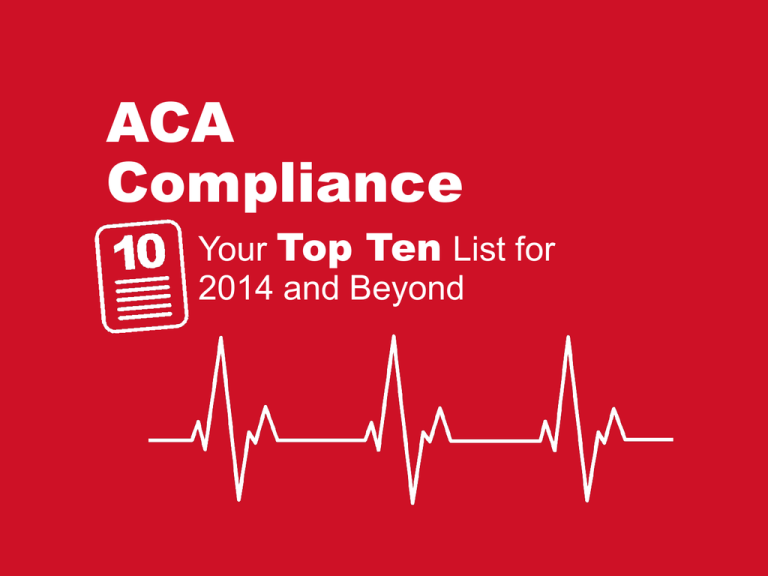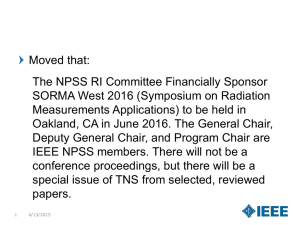Click here for power point presentation
advertisement

ACA Compliance Your Top Ten List for 2014 and Beyond Presentation by: AON Risk Solutions Dawn Montano Assistant Vice President 6501 Americas Parkway NE, Ste 650 Albuquerque, NM 87110 (505) 889-6748 Dawn.montano@aon.com 1 Employer Mandate and Penalties Begin in 2015 Failure to Offer Penalty • Employer does not offer Minimum Essential Coverage (“MEC”) to at least 95% of all FTEs and their eligible dependents, and • At least one FTE enrolls in Exchange and receives Federal subsidy – $2,000 per year for each FTE (minus first 30 FTEs) within controlled group entity Or Targeted Penalty • Employer offers MEC to FTEs but coverage is either – “Unaffordable” or – Not “minimum actuarial value” • $3,000 per year per each FTE who enrolls in an Exchange and receives a Federal subsidy ACA – Employer Mandate Affordability Rules • Affordability Test – Affordability test for purposes of the premium tax credit is based on the cost of self-only coverage, even if the employee elects family coverage – An employer-sponsored plan is affordable if the FTEs required contribution for self-only coverage under the plan does not exceed 9.5% of the applicable taxpayer’s household income for the taxable year. • The IRS has issued three safe harbors for the purpose of determining affordability – W-2 safe harbor (current year W-2 [Box 1]) – Rate of pay safe harbor – Federal poverty level line safe harbor – (9.5% of FPL is approximately $1,100 per year – “safest choice” and allows for simple reporting) How do you determine FTEs under the Look Back Method? Under the Look-Back Measurement Method, an employer • • • • Must establish an Initial Measurement Period (IMP) – No less than 3 months and no more than 12 months May establish an Administrative Period – No more than 90 days Must establish a Standard Measurement Period (SMP) – No less than 3 months and no more than 12 months – Employer determines months in which SMP starts and ends • Must be uniform • Can use starting and ending payroll periods if additional rules are followed Must establish a Stability Period – Period of time for which FTE must be offered coverage – Stability Period must follow and be associated with an IMP and SMP 2014 Transition Measurement Periods for Stability Periods Starting in 2015—Ongoing Employees Employer wants to use a 12-month SP beginning in 2015 Employer may adopt a transition measurement period that is shorter than 12 consecutive months, but at least 6 consecutive months, and that begins no later than 07/01/2014 and ends no earlier than 90 days before the first day of the plan year beginning on or after 01/01/2015 – Applies to employees as of the 1st day of the transition measurement period – If an employee is hired during or after the transition measurement period, general Look-back rules apply Transition Standard Measurement Period (04/15/2014–10/14/2014) Does Not Work “FullTime” Standard Measurement Period #2 (10/15/2014–10/14/2015) Works “Full-Time” AP #1 10/15/14– 12/31/14 Standard Measurement Period #3 (10/15/2015–10/14/2016) Does Not Work “FullTime” AP #2 10/15/15 – 12/31/15 Stability Period (01/01/2015–12/31/2015) Don’t Offer Coverage Aon Hewitt | Health & Benefits Proprietary & Confidential | April 30, 2014 AP #3 10/15/16 – 12/31/16 Stability Period #2 (01/01/2016–12/31/2016) Offer Coverage (MV) Stability Period #3 (01/01/2017–12/31/2017) Don’t Offer Coverage 6 Look-Back Measurement Method Example—Ongoing Employees Employer uses a 12-month SMP period that begins October 15 and ends October 14 Employer uses an AP from 10/15–12/31, following the end of the SMP – During APs, employer “looks back” (see elbow arrows below) at total hours of service in SMP to determine if employee was employed on average at least 30 hours/week – Employee has 1,820 total hours of service during SMP #1; 1,820/52 weeks = 35 average hours/week – Employee has 1,500 total hours of service in SMP #2; 1,500/52 weeks = 28.84 average hours/week – Employee has 2,080 total hours of service in SMP #3; 2,080/52 weeks = 40 average hours/week Employer offers coverage during a 12-month SP that equals the calendar plan year Based on hours worked during the SMPs, employee is eligible for coverage in the 2015 plan year and the 2017 plan year, but not eligible for coverage in the 2016 plan year Standard Measurement Period #1 (10/15/2013–10/14/2014) Works “Full-Time” Standard Measurement Period #2 (10/15/2014–10/14/2015) Does Not Work “Full-Time” AP #1 10/15/14– 12/31/14 Standard Measurement Period #3 (10/15/2015–10/14/2016) Works “Full-Time” AP #2 10/15/15– 12/31/15 Stability Period #1 (01/01/2015–12/31/2015) Offer Coverage (MV) Consulting | U.S. Health & Benefits Proprietary & Confidential | 06/2014 AP #3 10/15/16– 12/31/16 Stability Period #2 (01/01/2016–12/31/2016) Don’t Offer Coverage 7 Stability Period #3 (01/01/2017–12/31/2017) Offer Coverage (MV) Look-Back Measurement Example—New Variable Hour Employee Variable Hour Employee hired on May 10, 2015 – 12-month IMP beginning on date of hire (05/10/2015-05/09/2016) – 1+ month AP from the end of the IMP through the end of the 1st calendar month beginning on or after the end of the IMP – During the AP, employer “looks back” (see elbow arrow below) at total hours of service in IMP – 12-month SP Initial Measurement Period (05/10/2015–05/09/2016) Consulting | U.S. Health & Benefits Proprietary & Confidential | 06/2014 AP 05/10/2016– 06/30/2016 12-Month Initial Stability Period (07/01/2016–06/30/2017) 8 Look-Back Method—Transitioning New Variable Hour E/ee to Ongoing Employee Variable Hour Employee hired on May 10, 2015; 12-month IMP begins 06/01/2015 and ends 05/31/2016 – During the AP (06/01/2016–06/30/2016), employer looks back at employee’s hours of service during the IMP • Works “full-time” during the IMP (1,560 total hours/52 weeks = 30 average hours of service/week) – Must be treated as a full-time employee and offered coverage during the entire, associated ISP (07/01/2016– 06/30/2017) – Does not work “full-time” during his first SMP following (that begins after) his start date (10/15/2015–10/14/2016) • During the AP (10/15–12/31), employer looks back at employee’s hours of service during the SMP • Employee has 1,456 total hours of service during SMP; 1,456/52 weeks = 28 average hours of service/week – Is not required to be offered coverage during remaining portion of SP for ongoing employees after the SMP (07/01/2017–12/31/2017) • Treat the employee as not a full-time employee only after the end of the ISP associated with the IMP AP Employee Hired 05/10/2015 Initial Measurement Period (06/01/2015–05/31/2016) Works “Full-Time” AP 06/01– 06/30 12-Month Standard Measurement Period (10/15/2015–10/14/2016) Does Not Work “Full-Time” Consulting | U.S. Health & Benefits Proprietary & Confidential | 06/2014 12-Month Initial Stability Period (07/01/2016–06/30/2017) Offer Coverage (MV) AP 10/15– 12/31 Stability Period (01/01/2017– 06/30/2017) Covered by Initial Stability Period 9 Remainder of Stability Period (07/01/2017– 12/31/2017) Don’t Offer Coverage Look-Back Method—Transitioning New Variable Hour E/ee to Ongoing Employee Variable Hour Employee hired on May 10, 2015; 12-month IMP begins on start date AP from the end of the IMP through the end of the 1st calendar month beginning on or after the end of the IMP Does not work “full-time” during the IMP – Employee has 1,456 total hours of service during IMP; 1,456/52 weeks = 28 average hours of service/week Not required to be offered coverage during the ISP Works “full-time” during his/her first overlapping or immediately following SMP; 1,560/52 weeks = 30 average hours of service/week Must be treated as a full-time employee for the entire SP that corresponds to that SMP – Offer coverage during the entire SP that overlaps the portion of the first ISP (01/01/2017–06/30/2017) • Offer coverage 01/01/17–12/31/17 Employee Hired 05/10/2015 Initial Measurement Period (05/10/2015–05/09/2016) Does Not Work “Full-Time” AP 12-Month Initial Stability Period (07/01/2016– 12/31/ 2016) Don’t Offer Coverage 12-Month Standard Measurement Period (10/15/2015–10/14/2016) Works “Full-Time” Consulting | U.S. Health & Benefits Proprietary & Confidential | 06/2014 AP Stability Period (01/01/2017–12/31/2017) Offer Coverage (MV) Stability Period “cuts short” the ISP of no coverage to 07/01/2016–12/31/2016 10 2 THE EMPLOYER MANDATE AND ELIGIBILITY for Exchange Subsidies Individual is not eligible for subsidized coverage if offered affordable health care coverage of minimum value from an employer • Employer must offer dependent coverage (not spousal coverage) to employee to avoid penalty, but coverage does not have to be “affordable” • Individual enrolled in employer-sponsored MEC not eligible for a subsidy – Regardless of whether coverage is affordable or minimum value What happens if an employed individual is offered “affordable” employee-only coverage, but family coverage is “unaffordable”? • Employee and family will not be eligible for subsidy in the exchange 3 Proposed Regulations on Reporting Rules Code Section 6055 requires reporting to IRS by plan sponsors and health insurers about health care coverage offered to individuals and requires statements to individuals Code Section 6056 requires employers to file a return with the IRS about health care coverage provided to FTEs and provide a written statement to FTEs When to File with IRS? February 28, 2016 for 2015 coverage year When to Provide to Individuals? January 31 following calendar year of coverage When to File with IRS? For 2015, March 1, 2016 or March 31, 2016 (if filed electronically) When to Provide to FTEs? January 31 following coverage year 4 Transitional Reinsurance Fee Designed to Stabilize Exchanges Reinsurance fund stabilizes insurers in exchanges during their first three years in the event of losses due to adverse selection Fees are due in installments Fees are required only for “major medical coverage” • 2014 per capita payment ($63) due in two installments • 2015 per capita payment ($44) due in two installments 5 Cost-sharing Limits Start in 2014 Health plans must limit annual costsharing to same cost-sharing limits • $6,350 (individual) and $12,700 (family) as HDHP/HSA plans in 2014 • OOP limits apply only to payments for essential health benefits (“EHBs”) Transition rule for 2014 for multiple service providers For 2015, medical and Rx carve-out may use separate OOP limits, as long as combined OOP limit applicable to all EHBs does not exceed maximum OOP limit – Payments for non-network providers and non-covered services do not count 6 What Is— And Isn’t— Minimum Essential Coverage? Minimum Essential Coverage does not include “excepted benefits” Excepted benefits don’t have to comply with ACA group market rules but won’t satisfy mandates • FSA is an excepted benefit only if employee has other health care coverage available – FSA cannot exceed greater of (1) 2 x salary reduction amount or (2) $500 plus salary reduction amount – Must be offered through a Section 125 cafeteria plan • Limited scope dental and vision benefits • Disability coverage, AD&D coverage, liability insurance, Workers’ Comp • EAPs that do not provide significant benefits in the nature of medical care or treatment 7 HRAs and the ACA HRAs must be integrated with another ACA-compliant group health plan in order to comply with ACA group market reforms • Stand-alone HRAs and employer payment plans violate ACA rules prohibiting annual dollar limits and requiring 100% preventive care coverage • Stand-alone retiree-only HRAs are not subject to the ACA group market reforms Previous guidance outlined minimum value and nonminimum value options for an HRA to be considered “integrated” • HRA can only be available to employees enrolled in other group health plan coverage – Employer does not have to sponsor the other coverage • Participant must be able to permanently opt out and waive HRA coverage – Participant must have the option of permanently forfeiting the HRA upon termination of employment 8 HPID Health Plan Identifier Health Plans are required to use a Health Plan Identifier (HPID) in HIPAA standard electronic transactions For fully-insured plans, the carrier will obtain the HPID Self-funded plan sponsors will need to obtain their own HPID • Health plan must obtain a HPID by November 5, 2014 • Extended deadline until 2015 for small health plans (less than $5 million in annual receipts) • HPID applications are available through the CMS Enterprise Portal at https://portal.cms.gov/ 9 FSA Carryover Option Employers can allow FSA participants to carry over up to $500 of unused FSA funds for use in subsequent plan years • Does not count toward $2,500 health FSA maximum amount • Employers cannot utilize both the grace period rule and the $500 carryover rule • Consider impact on HSAs Employers who want to adopt the $500 carryover rule must amend their plan documents on or before the last day of the plan year from which the amounts may be carried over • For 2013, amendment can be made by last day of plan year that begins in 2014 10 Excise Tax on High Cost Employer Health Care Coverage Effective in 2018, 40% excise tax is imposed on excess employer health care benefits The excess benefit is coverage over certain indexed thresholds Coverage includes employer contributions and employee pre-tax contributions under cafeteria plans Self-Only Coverage: $10,200 $11,850 for “qualified retirees” and high risk professions Other than Self-Only Coverage: $27,500 $30,950 for “qualified retirees” and high risk professions Employers Need to Comply with ACA and Reduce Costs Your Health Care Compliance Strategy Your Health Care Strategy What do you have to do? When? What are your options? What is your long-term plan to reduce your health care costs? Questions? Contact: AON Risk Solutions Dawn Montano Assistant Vice President 6501 Americas Parkway NE, Ste 650 Albuquerque, NM 87110 (505) 889-6748 Dawn.montano@aon.com








